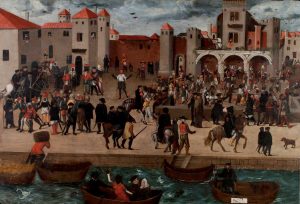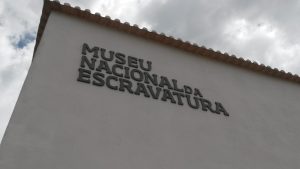Is Afropean a Project Towards Emancipation? Part 2: A Personal History of the Impact of Portuguese Colonisation
Written by CS Bastos Gomes Pinto
In Black Skin, White Masks, Frantz Fanon explains how black children in colonised Martinique learned to identify themselves with the white characters of popular magazines. White characters were continuously portrayed as the heroes of those narratives while, “the Wolf, the Devil, the Evil Spirit, the Bad Man, the Savage are always symbolized by Negroes or Indians”. I too was taught in school that the Portuguese had offered “more worlds to the world”; they had civilised and Christianised Africa; there was slavery, but Portugal was the first nation to end slavery. On the other hand, while I was growing up, I used to watch American movies and Brazilian soaps, many of which discussed slavery, colonialism and racism. And, mainly from my mother, I heard stories of Angola during colonial times, about the nationalist movements, about Queen Nginga (Nzinga). But I used to take school education (too) seriously, considering everything I would learn there as the absolute truth. It took a while until I started to make sense of these historical movies, narratives about enslaved people in Brazil, and my mother’s stories… of it all.
The transatlantic slave trade was initiated by the Kingdom of Portugal in the 15th century. The Portuguese were looking to find an alternative to Arab-controlled land trade by controlling the seas. According to the scholar Stuart Hall, the reasons for the Portuguese and, also, Spanish territorial expansion, were not only commercial, but also geopolitical and religious (spreading Christianity). In 1494, the Portuguese and Spanish Kingdoms decided to split the world in two so that any newly ‘discovered’ territories would be controlled by one of them. Eventually, other European kingdoms, such as the Dutch, the French and the English, likewise started to take control of overseas territories. Jump forward centuries later, during the Berlin Conference of 1884, most of the African continent would be officially divided between several European nations (Belgium, Germany, France, Britain, Italy, Portugal and Spain) – see ‘The Scramble for Africa’. Once again, besides their geopolitical interests, the European powers would see as their mission (‘the white’s man burden’) to civilise African peoples.
Stuart Hall, borrowing Edward Said’s concept of ‘Orientalism’, explains how the ‘West’ (Europe/North America) created and positioned itself as superior/civilised in opposition to the ‘Rest’, whom were considered savage/inferior, contributing to the formation of one common European identity. Hall explains that “despite their many internal differences, the countries of Western Europe began to conceive of themselves as a part of a single family or civilisation” – the West. The Rest, the colonised world, using Said’s words, was “politically, sociologically, military, ideologically, scientifically and imaginatively” produced as the ‘Other’, what Europe is not. Both Said and Hall underline that by producing the Rest (for Said, the Orient), European colonial powers secured their control over the colonised world.
Sadly, ‘othering’ narratives continue to be alive and well in children’s education throughout contemporary Europe. Marta Araújo and Silvia Rodríguez Maeso in Slavery and Racism as The ‘Wrongs” of (European) History: Reflection from a Study on Portuguese Textbooks state that “textbooks continue to deploy a colonial vocabulary, sanitized and depoliticized, that portrays slavery as a normal practice of ‘those times’. Anti-racist activists in Portugal have as well been calling attention to how enslaved people in “those times” are objectified and depicted as just another transaction product in these books. The glorification of the empire, the conquests or the portrait of a nation whose colonial domination was the most tolerant and benevolent, are example of narratives present not only in education, but also in the media, other institutions and in government leaders’ discourses (see also Alana Letin, Postracial Silences in The Othering of Race in Europe). The two researchers highlight how these narratives erase asymmetric power relations which characterized colonialism and slavery:
“This overall race/power evasive discourse mitigates the interrelation between colonialism, slavery and racism reinforcing a Eurocentric production of history that subsumes power relations into specific equanimity, such that the wrongs of colonialism(s) and slavery can be measured, but only from the perspective of the colonizers and its collaborators.”
Let us look now to opposing evidence to these narratives. José Murilo de Carvalho (in O encobrimento do Brazil), a Brazilian historian, suggested that instead of using the term ‘discovery’ (descobrimento) regarding the European arrival in the Americas; we should be talking about a ‘cover-up’ (encobrimento). The use of ‘discovery’ seems to suggest that the 50 million people already living in the Americas only became real after Colombus’ arrival. In Brazil, during the first three centuries of Portuguese colonisation, around 3 million natives were decimated (through slavery, European plagues, extermination). Indigenous women were submitted to rape and other forms of gendered violence. As millions of Africans, thought of as being more resistant, were being transported in insalubrious and overcrowded ships. In the recent BBC show called Enslaved, it was emphasised that: “Over 2 million Africans died en route, and up to 1000 slave ships ended up as wrecks, with only a handful ever having been identified.”
Furthermore, the website Slave Voyages estimates that approximately 4.5 million enslaved people were transported by Portuguese and Brazilian identified ships, between 1501 and 1826 (Brazil became an independent nation in 1822). One of the places that I visited in Angola, in 2018 (unfortunately, the only time I have been to Angola), was the National Museum of Slavery (NMS). A small white building on top of a hill, looking towards the sea. Inside, among different type of chains, weaponry and statuettes, several museum labels attempted to stress how vast the slave trade was. Outside there was a plaque explaining:
“Founded in 1977, the NMS has as its main goal to illustrate and maintain in everybody’s memory the genocide which so many Africans were subject. The journey which men, women and children were forced to go through, in such a violent way, from the moment they were captured [/kidnapped] to the crossing of the Atlantic on the way to the Americas and to a life of complete submission.” (loosely translated).
In my view, the greatest of ‘cover-ups’ was the presence of African and African-descent peoples in Portugal before the 1970s. For instance, José Ramos Tinhorão (Os Negros em Portugal/Black People in Portugal) estimated that around 10% of the population of 16th century Lisbon, Alentejo and Algarve was of enslaved black people. According to António de Almeida Mendes (Slavery and Race in Portugal: A Long-Duration Experience), between 1440 and 1760, approximately 500-600 thousand Africans arrived at the Portuguese metropolis. The black presence in Lisbon was so noticeable that an Italian representative of the Pope (in 1595-1596) wrote:
“Since they have started to commercialize with the Indies and to subject those peoples, they introduced into this city (Lisbon) an infinity of peoples, who are all black. In a way that we can say that this city is more black than white, and there is no house where there is at least two, three or all families.” (loosely translated).
Although the enslaved population in Portugal was not only made up of black people nor people of African origin, the vast majority were and “the most arduous work was reserved for the blacks” (see James H. Sweet in The Iberian Roots of American Racist Thought). The Portuguese expression “trabalhar como um mouro” (“to work as a moor”) is used to this date. African manpower was significantly present in domestic services, agriculture and craftwork. Nevertheless, enslaved and free black people could be found occupying different positions (street vendors, knights, entertainers, etc.) in ‘The King’s Fountain’, a 16th century painting from an unknown Flemish author. African kings would also send family members to be educated in Portugal. According to the historian Lucilene Reginaldo, in “Africa in Portugal”: Slavery, Religious Devotion and Black Brotherhoods during the 18th century Portuguese Kingdom, ordained black priests were also present in religious processions. Furthermore, black people in Lisbon would organise themselves in Christian Black brotherhoods, who would come in their defence against abusive masters and gather money to buy freedom for fellow slaves.
Abuse and dehumanisation of racialised bodies, namely of enslaved women, were taken to extremes in Alentejo and other regions of the Portuguese countryside. Christiana Martins (O Segredo dos Escravos Reprodutores/ The Secret of the Breeding Slaves) reveals that enslaved people were forced to breed as “horses”. The journalist shares the following passage from a 16th century document (trigger warning):
“The creation of Moor slaves, some of whom are reserved only for the fertilization of great numbers of women, as stallions, taking their record as horse breeds in Italy. Let those women be mounted for whoever wants, since the foal [woman] always belongs to the owner of the slave and it is said that there are a lot of pregnant [women]. Of these herds of females, there are many in Portugal and in the Indies, only for the sale of the offspring.” (loosely translated)
The number of black people in Portugal was considerably reduced after the 1755 tsunami and with the abolition of slavery in the metropolis (not in the colonies) in 1761, a decision made by the Marquis of Pombal (probably an African descendant himself – see Bruno Sena Martins in Os Negros em Portugal). With Brazilian Independence (1822), enslaved and African-descent peoples from Brazil would arrive in the Portuguese Kingdom and contribute to the making of the Portuguese national music genre named ‘Fado’ (see Kimberley DaCosta Holtons in Fado Histography: Old Myths and New Frontiers). In 1869, slavery was completely abolished in all regions of the Portuguese empire. Slowly, this history began to be erased from the memory of the masses. According to the historian Arlindo Manuel Caldeira (Escravos em Portugal: das origens ao século XIX/Slaves in Portugal: from the origins to the XIX century), the last Portuguese woman who had been enslaved died during the 1930s.
Thus, my generation was not taught about African civilisations (apart from Egypt) in school. About queens and kings who fought and resisted European powers. Nor about the Africans who led revolutions and ended up acquiring their countries’ independence. We were taught about the glorious Portuguese past which ‘civilised’ people who looked like us. History teachings did not allow us to identify with African cultures and excluded us from the national narrative. The role of Portugal, my home country, in the transatlantic slave trade, one of the worst crimes against humanity, was almost ignored. But the African presence in Portugal can be traced to even before the transatlantic slave trade (at least from Roman times). Islamic peoples of North Africa also had a great cultural and genetic impact in the Portuguese territory before this period. The realisation of the long presence of African-descent peoples in Portugal, besides all, informs me that, as Paul Gilroy would have put it, being African/black and Portuguese are not “mutually exclusive”. It deconstructs West/Rest dichotomies and nationalist narratives. I also believe it that can enable all of us to have a more critical view of history and make connections with the present, to racialised social inequalities. Africans and African-descent populations across the world (including in Europe) continue to be affected by the consequences of the transatlantic slave trade and colonial legacies.
Afro-descent Europeans can likewise offer a fresh perspective over the history of transatlantic slavery and achieve recognition and reparations and change. The construction of the first slavery memorial in Portugal was approved in 2017 thanks to a project from an African-descent association called Djass.






